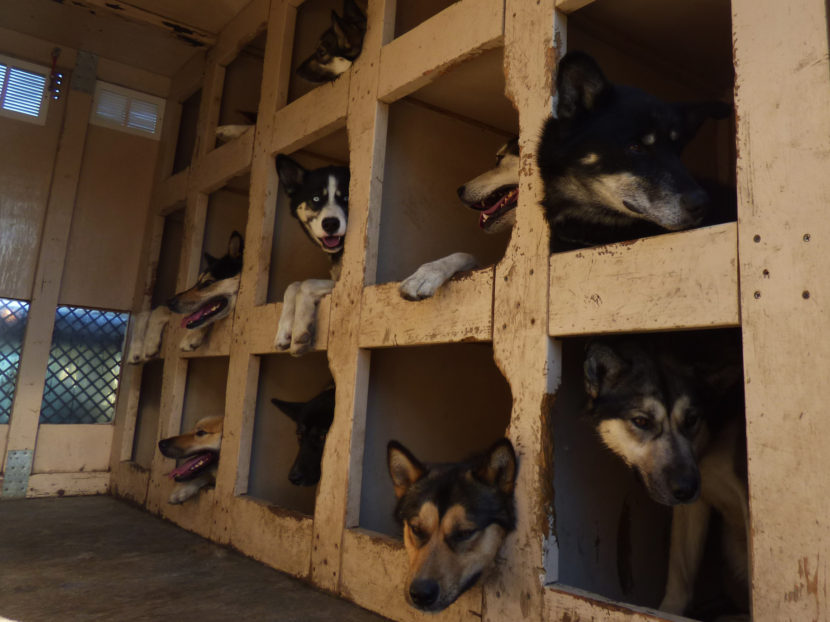There’s only one national park in America where some of the Rangers are canines: Denali National Park. In the summers, the dogs serve as ambassadors, but during the winter months they ferry researchers and park employees through areas closed to motorized vehicles.
Early on a crisp, fall morning a large white truck sits alone in a dirt parking lot at Riley Creek Campground.

Denali Kennel manager Jennifer Raffaeli takes six huskies out of the van, fits them in harnesses and hooks them to a line attached to a green metal cart that looks like a dune buggy. Raffaeli fastens her helmet.
On the trail, the only sound is the wheels whirring along the ground. The six-dog teams pull two humans around trails that wind in and around the campground.
On this day, each team is running about five miles, and then it’s back to the kennel. By the start of the winter season, the dogs will be doing 20-mile days. Over the course of the winter, they will log around 1,500 miles each.
It may seem backward, but Raffaeli said winter is the easiest time to move cargo through the park.
“Swamps and bogs and thick brush are the norm across Alaska,” Raffaeli said. “That’s challenging and slow going, especially if you are trying to move big heavy objects. When the park is covered with snow and rivers are frozen, you can carry huge loads because you’re not trying to carry them on your back. You’re sliding them over snow and ice, and that’s no problem for these guys.”
Pound-for-pound, Raffaeli said sled dogs are the strongest draft animals on the planet. That makes them the perfect tools for transportation through Denali’s designated wilderness — areas of the park that prohibit motorized vehicles.
Dogs have been a part of Denali for the entire history of the park. In 1921, Harry Karstens was hired as the park’s first superintendent and insisted on having dogs.
“It made perfect sense as you created a two-million-acre park, which is a huge area to try and cover as one person. You were going to need some dog teams to cover that,” Raffaeli said.
Back then, Raffaeli said dogs were the only way rangers could traverse the park and protect wildlife, like caribou and Dall sheep, from poaching. But over the years, the role of Denali’s sled dogs has changed.
In 1980, the Alaska National Interest Lands Conservation Act (ANILCA) labeled the original two million acres of Denali as wilderness — the highest level of federal land protection — and gave renewed purpose to the park’s sled dogs.

“The Wilderness Act requires that land managers look at the minimal tool for the task at hand,” Raffaeli said. “We’re always asking: Can we accomplish this project with dog teams?”
And if they can, they will. Over the winter, the teams are out for up to five weeks at a time. They haul supplies, support glacier research, and monitor man-made noise.
Plus, Raffaeli believes meeting a dog team in the field adds to the wilderness experience for park users.
“To encounter only a dog team on the trail — no snow machines, no other forms of motorized transport — is a form of peace and quiet and wildness that’s getting more and more rare,” Raffaeli said. “It’s more and more valuable that we continue that heritage here.”
That’s a heritage that in many ways is fading. Denali’s huskies aren’t just the best method of winter transport. They help preserve what many people remember as daily life in Alaska.
But in a rapidly changing climate, Raffaeli is uncertain about the future of the dogs.
“If we start to get warmer winters with less snow, how does that affect the dogs?” Raffaeli asked. “How do we evolve to face that new environment? I think those are really valid questions. But at the core of it all, I hope the dogs are always part of the story because they are such a special part of it.”
Back on the trail, the dogs are finishing their 30-minute morning workout. Raffaeli pulled into the campground parking lot and eases the team to a stop.
She jumped off and ladles water into one tin dog bowl after another. The dogs lap it up. When they are done, they go back in the van. It’s time for Raffaeli to get the next team ready for its five miles on the trail.
There’s no question, the dogs love their job.
Zoe Sobel is a reporter with Alaska's Energy Desk based in Unalaska. As a high schooler in Portland, Maine, Zoë Sobel got her first taste of public radio at NPR’s easternmost station. From there, she moved to Boston where she studied at Wellesley College and worked at WBUR, covering sports for Only A Game and the trial of convicted Boston Marathon bomber Dzhokhar Tsarnaev.




